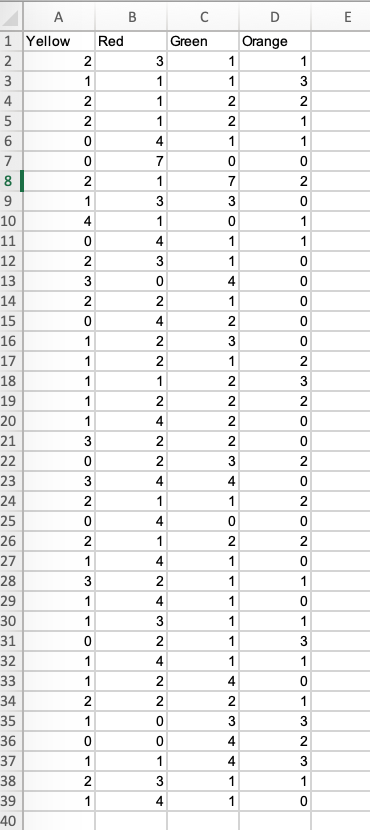Question
The owner of Haribo hires you to perform some statistical analysis. The owner knows that producing one yellow gummy cost 1 cent. Also, the price
The owner of Haribo hires you to perform some statistical analysis. The owner knows that producing one yellow gummy cost 1 cent. Also, the price for one red gummy is 1 cent. However, making one green gummy costs 5 cents, and producing one orange gummy costs 3 cents. These prices are well known in the company, and everyone refers to the yellow and red gummies a low-cost candy, and orange and green as the high-cost gummies. The marketing team developed a campaign to find out the gummy colors that clients prefer. Unsurprisingly, people prefer green and orange gummies. Hence, the marketing team wants to have those colors on every package. The team responsible for labeling the nutrition facts computes sugar and sodium content based on packages estimated to have seven gummies. Hence, the production team sets the machines to produce packages that are expected to have seven gummies. The financial team decided that the best way to minimize cost and fulfill the requirements of the marketing and nutrition teams is to produce packages expected to have one green and one orange gummy (high-cost group) and two yellow and three red gummies (low-cost candy). The accounting team is suspicious of the production process because their records show that the production cost per package is 17 cents and that price is larger than the expected price per package. They think that a possible explanation has to do with the number of high-cost gummies per package. Under normal circumstances, the expected cost per package of high-cost candy should be equal to the expected price per package of low-cost candy plus three cents.
- How many elements do you have in your sample? How many variables?
- What is the average number of gummies per package according to your sample? What is the sample standard deviation of the number of gummies per package?
- Compute a 95% confidence interval for the total number of gummies per package. What is your statistical conclusion? Are the nutrition facts labels accurate?
- What is the average price per package according to your sample? What is the sample standard deviation of the cost per package?
- If the production per package goes according to plan, what would be the expected price per package?
- Use your statistical knowledge to prove or refute the following claim: The current price per package is larger than the expected price per package if the production goes according to plan (hint: you computed the later number in the previous question).
- Using your sample and statistical knowledge, prove or refute the claim made by the accounting team: The current price per package is equal to 17 cents. Make your statistical claim with 99% of confidence!
- What is the average cost of low-cost candy per package? What is the sample standard deviation of low-cost candy per package?
- What is the average cost of high-cost candy per package? What is the sample standard deviation of high-cost candy per package? 1
- Under normal circumstances, the expected cost per package of high-cost candy should be equal to the expected price per package of low-cost candy plus three cents. Use your statistical knowledge to prove or refute if we are under normal circumstances of production.

Step by Step Solution
There are 3 Steps involved in it
Step: 1

Get Instant Access to Expert-Tailored Solutions
See step-by-step solutions with expert insights and AI powered tools for academic success
Step: 2

Step: 3

Ace Your Homework with AI
Get the answers you need in no time with our AI-driven, step-by-step assistance
Get Started


